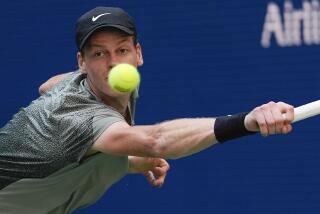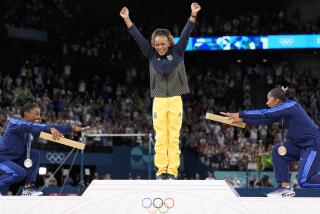All That’s Missing Is Happy Ending
- Share via
NEW YORK — This time, there weren’t hundreds of Brazilians in yellow shirts, cheering his every move. This time, there were no drums, celebrating his every shot. There was no clay.
And so, this time, Jaime Oncins of Brazil, unable to recapture the magic of a different time and place, lost a tennis match to Michael Chang of the United States.
This was the first round of the U.S. Open, where Chang’s 3-6, 6-1, 6-0, 7-6 (8-6) victory Monday appeared to the casual viewer to be a normal early-tournament showcase for an American star on Stadium Court. The lanky, curly-haired Oncins, Tour de France cap turned backward and blue eyes focused mightily on the task at hand, looked to most like cannon fodder for the bigger name.
Oncins appeared to be just another guy, ranked No. 186 in the world, trying for tomorrow’s big headline, for his Andy Warhol acclaim. Chopping down Chang could be Oncins’ “Jack in the Beanstalk,” since Chang, ranked No. 3 in the world and seeded No. 2 in this tournament by the U.S. Tennis Assn., and CBS, was truly a marquee player.
But appearances can be deceiving. There was a story line here much deeper than forehands and backhands and rankings.
In 1992, Oncins was 22, a clay-court player with a huge serve and huge promise, en route to a career-high ranking of No. 32. He beat an aging Ivan Lendl in the French Open, then followed that in mid-summer with a shocker in the Olympics at Barcelona.
It was a third-round match, on the slow red clay favored by the host Spaniards. The match was on the lowest court of the tiered tennis complex, and the wind on that day blew everything downhill to the court that seated, at its maximum, 500 people. That day, close to 1,000 showed up, dressed in Brazilian trademark yellow shirts and carrying Brazilian trademark drums. Most fans worldwide celebrate their teams by clapping hands and shouting. Brazilians beat drums.
They were there that day for Oncins, their Davis Cup star and, they felt, a real hope to beat the American star, Chang, whom many of the experts were picking to win the gold medal on the strength of his 1989 clay-court triumph in the French Open.
Win Oncins did, in four sets and in a theater of constant chanting, steady drum-beating and swirling wind that, as the afternoon wore on, simply became an Excedrin headache for Chang. With Pete Sampras and Jim Courier also exiting early, Oncins’ victory effectively ended American men’s medal hopes.
After the Olympics, Oncins came here to the U.S. Open with more giant-killing on his mind. And then he drew Jimmy Connors in the first round for a match that would bring Connors back for a last hurrah after his amazing run to the semifinals the previous year, on the Stadium Court that Connors seemed to own.
Also, the match would be played on Connors’ 40th birthday.
Oncins never had a chance.
“It was like a big party,” Oncins said Monday. “The stadium, it was totally full . . . I was, like, shaking, my whole body.”
After the U.S. Open, Oncins kept playing, but things started to slip. He got back to the U.S. Open in 1993 and immediately drew another legend making a comeback, Mats Wilander.
Wilander won in a final-set tiebreaker that went on and on and was memorable for many things, among them Wilander’s wandering over to the bleachers in mid-tiebreaker, when the score was getting up toward the 20s, and asking broadcaster and columnist Bud Collins, “Hey, Bud, what’s the record?” It was also memorable for an outburst by Oncins over a line call at 12-12 that resulted in a fine.
“I remember. Very important bad call,” Oncins said. “The fine was $2,500.”
Later that year, Oncins’ career stopped altogether. He was riding in a car with a group of friends after a soccer game and somebody fired a gun at the car. His best friend, sitting next to him, was hit in the head and died on Oncins shoulder.
“It was a moment I cannot forget,” Oncins said Monday. “It is tough to say what happened to me. I am never going to forget. It takes time for me to start to realize what happened. I was a disturbed person for a long time. Now I know it is something I must live with.”
He played, sometimes. And sometimes he didn’t. He tore ligaments in a knee, and his ranking slipped almost to 300, and he ended 1995 ranked 225th. Recently, after discussions with his girlfriend and family, he decided to, at 26, make one last attempt at success on the tour. He has played well enough to get his ranking into the top 200 and get him through a qualifying tournament and into the U.S. Open once again.
Then he drew Chang in the first round.
This time, the sentiment in the stands was red, white and blue, not yellow. And this time Oncins was clearly not the brazen Brazilian of 1992. He double-faulted 24 times, including on all four points he lost in one game, certainly a rarity on this level of tennis.
He also produced the choke of the day, after bravely fighting his way to two set points at 6-4 of a tiebreaker for the fourth set, sending his second serve nearly to the baseline.
“That moment was like an hour to me,” Oncins said. “I start to think, 6-4, I had to win this point, win this set, then have a chance in the fifth set. I forgot what I had to focus on.”
Chang, not playing his best tennis, but not foolish enough to let such an opportunity pass, ran Oncins’ ugly double fault into an 8-6 win in the tiebreaker.
But Oncins lost only a tennis match, certainly not his biggest loss in recent times. To hear him talk afterward, he had achieved enough satisfaction just in the struggle.
“Believe it or not,” he said, “this match for me, that fourth set for me, it’s like almost I win the game, because it was so important to me.”
Somewhere in Brazil, somebody who knows Oncins and knows what he has been through will read what he said and be pleased. They may even thump a drum.
(BEGIN TEXT OF INFOBOX / INFOGRAPHIC)
Featured Matches
Today’s featured matches at the U.S. Open:
DAY SESSION
Beginning 8 a.m. PDT
STADIUM COURT
* Men--No. 1 Pete Sampras vs. Adrian Voinea (Romania); Stefan Edberg (Sweden) vs. No. 5-Richard Krajicek (Netherlands)
* Women--No. 2 Monica Seles vs. Anne Miller
GRANDSTAND
* Men--No. 3 Thomas Muster (Austria) vs Javier Frana (Argentina).
* Women--No. 8 Lindsay Davenport vs. Adriana Serra-Zanetti (Italy); Jennifer Capriati vs. Annabel Ellwood (Australia).
NIGHT SESSION
Beginning 4:30 p.m. PDT
STADIUM COURT
* Men--No. 4 Goran Ivanisevic (Croatia) vs. Andrei Chesnokov (Russia).
* Women--No. 1 Steffi Graf (Germany) vs. Yayuk Basuki (Indonesia).
More to Read
Go beyond the scoreboard
Get the latest on L.A.'s teams in the daily Sports Report newsletter.
You may occasionally receive promotional content from the Los Angeles Times.







